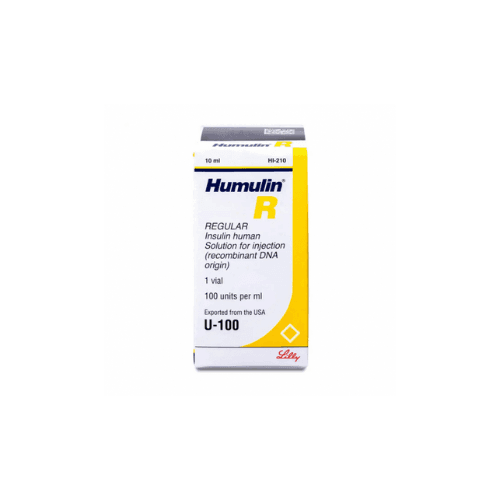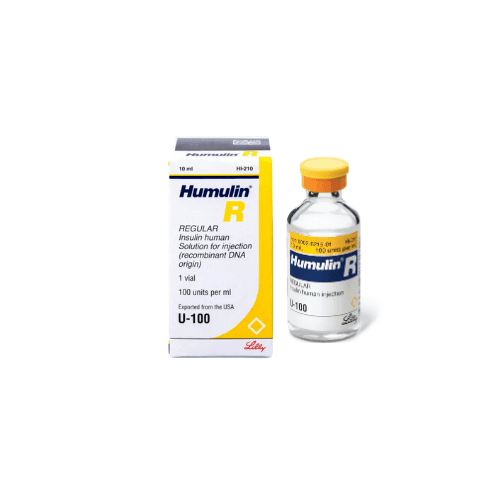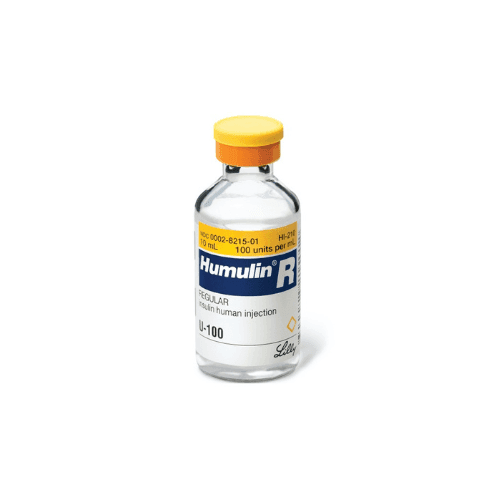Shipping with this method takes 3-5 days
Humulin R® Vial for Diabetes
Stock up and Save - Get 20% off when you buy 3 or more of any one product. Use code SAVE20 at checkout.
Coupon code cannot be combined with other offers. Sale applies to all products originating from Canada. Maximum allowable quantity equal to a 90 day supply per single order.
$113.99
Secure Encrypted Payments
Humulin R is a short-acting human insulin used to manage blood sugar in diabetes. An Insulin R vial gives dose-by-dose flexibility for meals and corrections, with US delivery from Canada. If you pay without insurance, this page explains options, safety points, and how to store and travel with the vial.
What Humulin R Is and How It Works
Humulin R® contains regular human insulin. It helps glucose move from the blood into muscle and fat, and reduces glucose release from the liver. After a subcutaneous dose, it usually starts working before a meal and covers the post-meal rise. Timing and effect can vary with dose, site, activity, and other medicines.
YouDrugstore is a licensed Canadian pharmacy in Manitoba. Pharmacists review prescriptions before dispensing.
This medicine is taken by injection under the skin. It is often used with a longer-acting basal insulin. Many people take it before eating, based on carbohydrate intake, current glucose, and prescriber instructions.
Who It’s For
This treatment is indicated to improve glycemic control in adults and children with diabetes mellitus who need insulin. It may be used for type 1 diabetes and for type 2 diabetes when diet, activity, and oral agents are not enough. An Insulin regular 10 mL vial can also be considered during pregnancy when insulin is needed, according to a clinician’s judgment.
Do not use it if you have a known hypersensitivity to this insulin or any component of the vial. Do not inject during an episode of low blood sugar. Diabetic ketoacidosis requires urgent medical care; follow clinical guidance, which may include intravenous insulin.
Dosage and Usage
Use exactly as prescribed. Typical use is a subcutaneous injection before a meal, with timing set by your prescriber. Your schedule may include doses at breakfast, lunch, dinner, and occasionally a correction dose. Rotate injection sites within the same region to reduce skin problems.
General steps:
- Inspect the vial; solution should be clear and colorless.
- Clean the vial stopper and injection site.
- Draw air into the syringe equal to your dose, inject air into the vial, then draw up the prescribed units.
- Remove air bubbles from the syringe by tapping.
- Inject under the skin of abdomen, thigh, buttock, or upper arm as directed.
Ask your clinician before mixing this insulin with other insulins. Some prescribers may mix regular insulin with NPH when clinically appropriate; follow professional instructions and the official label.
Check glucose regularly. Be prepared to treat low blood sugar with fast-acting carbohydrates and seek help if severe symptoms occur. Do not share syringes or needles.
Strengths and Forms
This vial is supplied as a clear, multiple-dose solution. Common presentations include a 10 mL vial. Concentration options may include U-100 and U-500; availability can vary by prescription and stock. Your prescriber will choose the concentration and volume that match your dose needs.
Many patients use a Humulin R 10 mL vial with standard U-100 syringes. Concentrated options are for those requiring larger daily totals determined by a clinician. Selection and substitution depend on your prescription.
Missed Dose and Timing
If you miss a mealtime dose, check your glucose and follow your prescriber’s plan. Avoid doubling the next dose. If you are unsure what to do, monitor closely and contact your healthcare professional. For frequent misses, discuss a dosing strategy that fits your routine.
Storage and Travel Basics
Keep unopened vials in the refrigerator as directed on the label. Do not freeze. Protect from excessive heat and light. Once in use, follow the official in-use storage time and temperature on the product label. Keep the cap on the vial when not in use. Store out of reach of children and pets.
For travel, carry vials and supplies in your hand luggage. Use an insulated carrier with cold packs if recommended by your prescriber and the label. Keep a copy of your prescription for security checks. Pack extra syringes, alcohol swabs, and glucose sources. Avoid leaving insulin in a hot car or directly on ice.
Benefits
The treatment helps cover meal-related glucose rises and can be tailored to carbohydrates and glucose readings. Vials allow fine-tuned dosing with syringes. Many patients find it fits well with a basal-bolus plan. It can be used alongside nutrition guidance and activity plans from a clinician.
Humulin R Vial offers a familiar option for those who prefer vial-and-syringe administration. It supports flexible timing around meals when supervised by a prescriber. Dose adjustments are individualized over time.
Side Effects and Safety
- Low blood sugar: shakiness, sweating, dizziness, fast heartbeat, hunger, headache.
- Injection-site reactions: redness, swelling, or itching at the site.
- Weight gain or mild fluid retention.
Serious effects can include severe hypoglycemia, severe allergic reactions, and low potassium. Seek urgent care for confusion, seizures, or loss of consciousness. The risk of low blood sugar may increase if used with other glucose-lowering medicines like sulfonylureas or with alcohol. Tell your prescriber about all medicines, vitamins, and supplements you take.
Drug Interactions and Cautions
Medicines that can raise glucose and increase insulin needs include corticosteroids, some antipsychotics, and certain diuretics. Agents that may lower glucose or increase sensitivity include alcohol, some ACE inhibitors, and GLP-1 receptor agonists. Beta blockers can mask some symptoms of low blood sugar. Always discuss changes in medicines with your clinician.
Illness, stress, and changes in diet or activity can alter insulin needs. Check glucose more often during changes and follow clinical guidance.
What to Expect Over Time
At the start, your clinician will set an initial plan and help you learn injection technique. Early adjustments may focus on pre-meal timing and matching doses to meals. With consistent use, many patients see steadier readings around meals. Ongoing follow-up helps refine the plan and reduce lows.
Keep a log of doses, food, and readings. Bring records to appointments so your prescriber can help optimize your regimen. Ask about sick-day guidance and how to handle exercise days.
Compare With Alternatives
Another regular insulin option is Novolin GE Toronto Vial, which is also human regular insulin. Some patients use a rapid-acting insulin for meals, such as Humalog Vial, when faster onset is preferred. Your clinician can help choose between regular insulin and rapid analogs based on your meals, targets, and risk of lows.
Pricing and Access
See current pricing at checkout and compare options on one page. Many self-pay customers look for a Humulin R vial price that fits their budget. We display transparent details before you place an order. For additional savings, check our Promotions page for occasional offers.
If you prefer to pay out of pocket, you can review a Humulin R vial cost estimate and plan refills ahead. We provide US shipping from Canada with clear tracking. Prescription required and verified; encrypted checkout protects your information.
Availability and Substitutions
Stock can change. If a specific vial size or concentration is unavailable, your prescriber may recommend an alternative that suits your dosing plan. Do not switch products or concentrations without professional guidance.
Patient Suitability and Cost-Saving Tips
This medicine may suit people who want flexible mealtime coverage, who are comfortable with syringes, and who can monitor glucose consistently. Those with frequent lows or difficulty matching doses to meals may need a different approach set by a clinician.
- Multi-month fills: Ask your prescriber about longer supplies to reduce trips.
- Refill reminders: Set calendar alerts so you do not run out.
- Training: Review injection technique to reduce waste and improve accuracy.
- Supplies: Keep extra syringes and alcohol swabs on hand.
Questions to Ask Your Clinician
- How far before meals should I inject this insulin?
- Can I mix it with NPH, and if so, how should I draw them up?
- What signs of low blood sugar should prompt action or medical help?
- How should I adjust on sick days or when I exercise more?
- Is a different mealtime insulin better for my routine and goals?
- What storage temperature and in-use time apply to my vial?
Authoritative Sources
Ready to order from YouDrugstore? We offer prompt, express, cold-chain shipping with clear tracking, and orders ship with care. Ships from Canada to US. This content is for general information and does not replace the advice of your healthcare professional.
Explore more: Type 1 Diabetes, Type 2 Diabetes, Diabetes Care, Does Metformin Cause Diarrhea, National Diabetes Month
Express Shipping - from $25.00
Prices:
- Dry-Packed Products $25.00
- Cold-Packed Products $35.00
Shipping Countries:
- United States (all contiguous states**)
- Worldwide (excludes some countries***)
Standard Shipping - $15.00
Shipping with this method takes 5-10 days
Prices:
- Dry-Packed Products $15.00
- Not available for Cold-Packed products
Shipping Countries:
- United States (all contiguous states**)
- Worldwide (excludes some countries***)
How long before a meal should I inject regular insulin?
Most patients are instructed to inject regular insulin shortly before a meal so it covers the post-meal rise in glucose. The exact timing depends on your plan, your glucose, and what you are eating. Your clinician sets the interval that fits your needs. If you are unsure on any given day, monitor closely and follow the guidance on your prescription label.
Can I mix this insulin with NPH in the same syringe?
Some clinicians may direct patients to mix regular insulin with NPH under specific instructions. This requires the correct order of drawing up, careful dose measurement, and consistent injection technique. Do not mix unless your prescriber has told you to do so and taught the steps. If mixing is prescribed, ask how to store the vials and which insulin goes into the syringe first.
What are the common side effects of regular insulin therapy?
The most common effect is low blood sugar, which can cause shakiness, sweating, hunger, headache, and dizziness. Injection-site redness or itching can occur. Weight gain or mild swelling may also happen. Severe hypoglycemia, allergy, or low potassium are less common but require urgent help. Review sick-day rules and keep fast-acting carbohydrates available for symptoms of hypoglycemia.
How should I store my vial at home and when traveling?
Follow the label for storage. Keep unopened vials refrigerated and do not freeze. Protect from heat and direct light. Once in use, follow the in-use time and temperature listed on the product label. For trips, carry insulin in hand luggage, use an insulated case if advised, and keep a copy of your prescription for security checks. Avoid leaving insulin in a hot car.
What should I do if I miss a dose before a meal?
Check your blood sugar and follow your prescriber’s instructions for missed doses. Do not double the next dose. Monitor more frequently and treat low or high readings according to your care plan. If you have repeated missed doses, discuss options to simplify timing or adjust the regimen so it better fits your routine and meals.
How is this different from rapid-acting mealtime insulin?
Regular insulin typically starts working later than rapid-acting analogs and may last longer after a dose. Some people use rapid analogs for meals when faster onset is preferred, while others stay with regular insulin based on goals, cost, and comfort with timing. Your clinician can help decide which option aligns with your meals and risk of hypoglycemia.
Can other medicines change how much insulin I need?
Yes. Corticosteroids and certain diuretics can increase glucose, often raising insulin needs. Alcohol, some ACE inhibitors, and GLP-1 receptor agonists can lower glucose or increase sensitivity, which may raise the risk of hypoglycemia. Beta blockers can mask warnings of low blood sugar. Tell your prescriber about all medicines and supplements you use before making changes.


